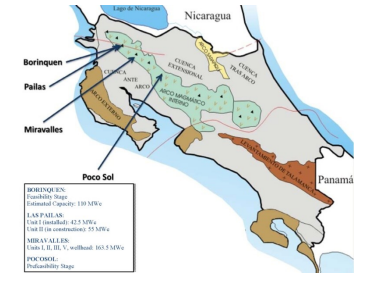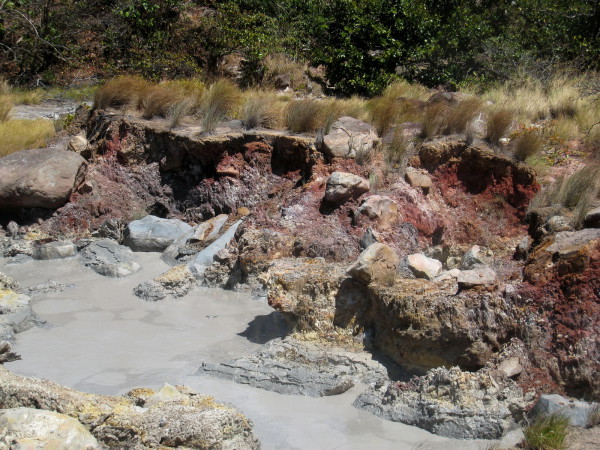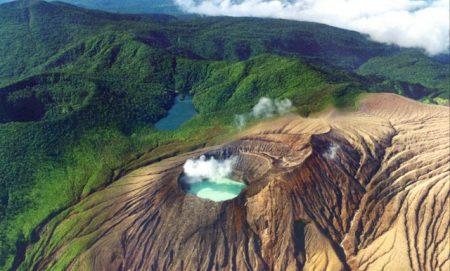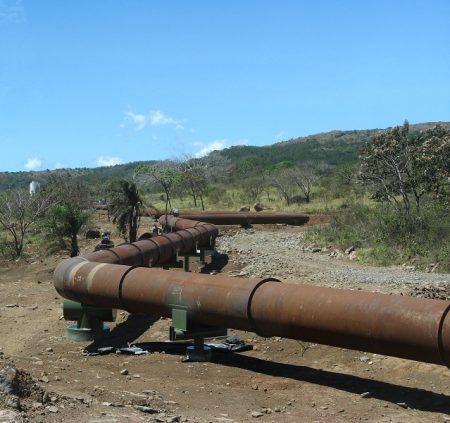February 9, 2017 – It is the last day of our two-week stay here in Costa Rica. Yesterday we visited Rincon de la Vieja, the largest volcano in the country, and a source of geothermal power that represents only a small part of the energy potential of this nation.
In 2013, geothermal sources accounted for less than 8% of the country’s total electrical power generation capacity. But that 8% produced 15% of the total energy consumed by Costa Ricans.

Why the difference between capacity and actual power consumption? Geothermal, unlike solar and wind, represents baseload capacity because the source of the energy is the continuous heat lying underneath Costa Rica’s geologically active volcanoes.
At Rincon, we didn’t get to the main caldera (see image at the bottom of this posting) which would have required an all-day hike uphill and back. Instead my wife and I traveled along a 3 kilometer trail that wound through a variety of landscapes including lush rainforest and dry desert-like scenes. We visited fumaroles, boiling mud fields with mini-geysers, steaming water pots and a volcancito (Spanish for, tiny volcano), growing on the flanks of the larger active peak.

Water contacting the magma chamber under the mountain was producing megatons of steam, a perfect source for driving turbines connected to generators.
As we approached the hiking trail, large pipes snaked across the landscape. These conduits of power generation disturbed what was a pristine landscape, bearing a similarity to Yellowstone in the United States, but with added tropical and dry rain forests, and howler and spider monkeys.
Rincon is one of the volcanoes contributing to Las Pallas, a geothermal installation consisting of five power plants contributing as much as 41.5 Megawatts of energy for the country. The energy derived comes from seven production wells and four injection wells. The injection wells are used to feed water into the underground chamber of hot rock. The production wells channel the steam to the surface where they provide the energy to drive turbines attached to generators.
It seems obvious to me that geothermal would be a key component in Costa Rica’s efforts to become a renewable energy powerhouse. The country has 100 volcanoes with six currently active. Yet it has only begun to tap the potential that lies beneath.
Having said that Costa Rica, unlike most countries in the world, pretty much generates all of its energy needs from renewable sources today including hydro and wind.
Do you need volcanoes to exploit geothermal energy capacity?
No. Back in October of last year, I wrote about the plume geothermal capacity of the United States. No volcanoes involved. Yet the U.S. continues to develop its geothermal potential at a snail’s pace.
In 2016 the global operating capacity of geothermal was spread across 24 countries and amounted to 13.3 Gigawatts. This year will add 12.5 Gigawatts covering 82 countries. And future estimates indicate an additional 18.4 Gigawatts to be added by 2021. By 2030 geothermal is expected to contribute 32 Gigawatts of power globally. This represents a 500% increase in geothermal capacity from 2014 but only 6 to 7% of the current global potential.
32 Gigawatts, when compared to solar growth is a mere fraction. In just one year solar capacity grows by that amount. And when compared to total energy consumed by humanity, over 104 Terrawatts, geothermal is a mere drop in the bucket.










